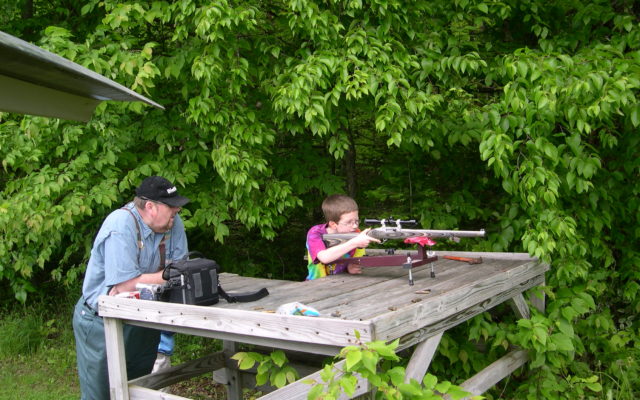Around the time I turned 8 years old, my father began to teach me about guns, shooting, hunting and especially firearm safety. At least every other warm weather weekend, he would find an hour or two for some kind of target practice. Some outings included friends or other family members, but often it was just the two of us, and we continued until I went off to college.
Each outing varied. Sometimes we used .22s, other times it was shotguns and hand thrown clay targets, and toward autumn we got out the deer rifles. Paper targets at various ranges were the norm, but sometimes there were tin cans or plastic jugs, and even balloons. My favorite outings were trips to the town dump to whittle down the rat population. I was a child of the 60s and shooting rats was common practice for future big game hunters.
Times have changed. No more open dumps and rats, far fewer opportunities to plink cans in the field behind the house and a train load of technical advancements in firearms, ammo, targets and gear for safe shooting. Ear and eye protection were like sunscreen back in my adolescence — available but seldom utilized. The one major aspect that hasn’t changed is the ongoing need for mentors and advocates to teach and guide youngsters and novice adults with the ins, outs, and roundabouts of shooting, hunting and wildcraft.
The first big, most important step is to actually make plans, take a friend or family member and go shooting. Secondly, be fully prepared with all the essential accessories for safety and success. Foremost, ear protection is mandatory, even something as simple as a one dollar pair of moldable, foam ear inserts. The next step up is a pair of ear muff style protectors. These can be as inexpensive as $20.
For dual protection from big booming guns or prolonged shotgun sessions, many experienced gunners use a set of ear muffs over foam inserts.
There are several models of molded ear inserts, and prices increase with quality and number of features, but then how much is your ability to hear really worth? Molded ear plugs are impossible to insert incorrectly so you get full protection every time and for a bit more money the advanced models feature sound amplification. Amplifying muff models are also available and allow conversation at the target range and improve hearing when afield as well.
Eye protection is another often overlooked safety measure while shooting for pleasure or practice. Injuries to the eye are a much rarer occurrence at the target or skeet range than when actually hunting, but accidents happen. Pieces of targets, hot gases and powder from fired shells, or even a freak ricochet, exploding shell or malfunctioning firearm can cause severe damage that even a $20 pair of shooting glasses can prevent.
Tinted lenses in shooting glasses can improve vision and increase accuracy on the range or in the trap and skeet fields. Orange and rose lenses make orange targets stand out. For bright sun, try gray, brown or purple to pick up targets better and for hazy days use yellow. Steer clear of very dark lenses as they make targets difficult to see, and don’t forget, sunglasses can be purchased with bifocal or prescription lenses.
There are a few more pieces of modern gear that make shooting outings more convenient and comfortable. Hard-sided gun cases for long guns and handguns offer great firearm protection during transportation and lock to assure only you have access. They also offer a soft, clean spot to rest guns when not in use at outdoor shoots. Range bags, also called gun and gear satchels, are another great asset for shooting outings. These are a perfect way to keep essential equipment together and transport it to and from shoots.
Along with hearing protection and glasses, most gun range bags have room for several boxes of whatever ammo is needed as well as compartments for expended shells and brass. A multitool, set of small screwdrivers for sight adjustments, portable gun cleaning kit and a couple of containers of cleaning solvents may prove essential. I put a bottle of water, sunscreen, insect repellant, a cleaning rag, a small folding saw, and tacks to hold targets in my range bag. Some folks carry a staple gun, extra staples and of course several paper targets.
Shotgunners will need a box of clay targets and either a hand target thrower or mechanical ground model. Plinkers who want more than paper targets may take a package of balloons or a bag of tin cans; never use glass containers of any kind for targets. Over the last couple of decades, a wide array of reusable metal targets have become available and very popular. There are spinners, bouncers, knock-down animal shapes, gongs, spring backs and many more challenging and entertaining options. Most are reusable and reasonably priced.
The weather is comfortable, especially early and late in the day and actual hunting options are very limited. The next few weeks are perfect to introduce someone to the sport of target shooting, and with actual upland, waterfowl and big game seasons mere months away, it’s never too early to practice. Be a mentor and an advocate for a Maine tradition. Even those who don’t become hunters may became avid target shooters.
- Outdoor writer Bill Graves, left, oversees Jack Anderson of Massachusetts during his first target shooting outing. Summer is the perfect time to mentor a prospective outdoorsman. (Courtesy of Bill Graves)








